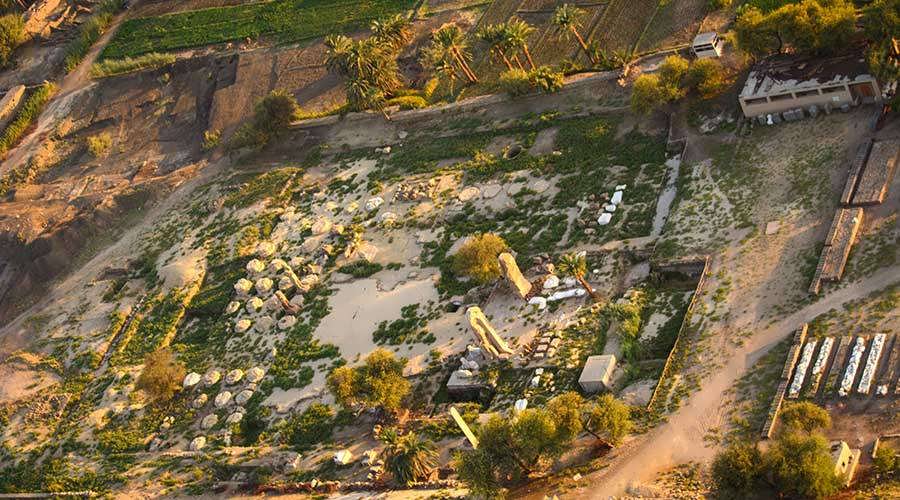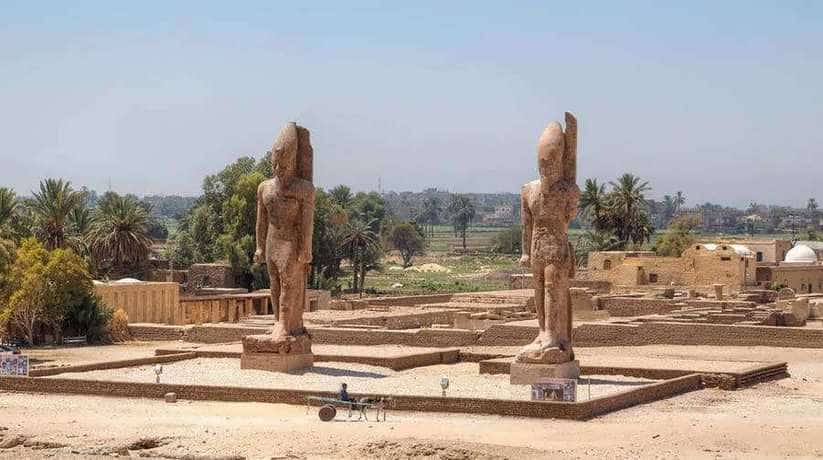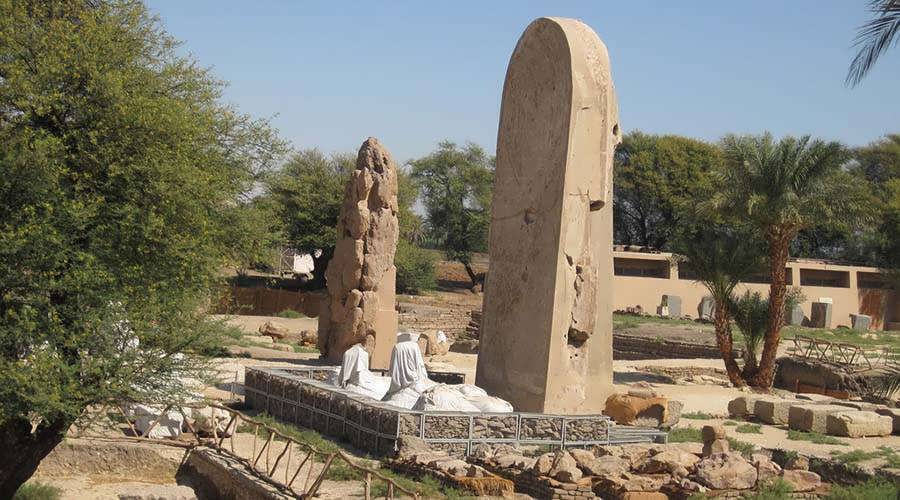Amenhotep III temple Luxor Egypt tours, booking, prices
Amenhotep III temple Luxor was the largest temple which built on the West Bank. It covered an area of 35 hectares and one of the largest religious structures in Egypt. At the time of construction in Dynasty XVIII, it would have superseded the Temple of Amun at Karnak in size. Kom El Hetan is the modern name for Amenhotep’s temple. It located about half a kilometer to the south east of Medinet Habu. In fact, it stretches from the Colossi of Memnon back to the bend by the Antiquities Inspectorate. Amenhotep III temple decayed rapidly. It is possibly due to the water content of the land it built on.
Until recently all that remained of the site were two massive colossal statues of the pharaoh. They stood at its entrance gateway, known since antiquity as the “Colossi of Memnon”. By early Dynasty XIX, Merneptah was able to re-use many blocks from the site of Amenhotep III temple Luxor. He reused them in the construction of his own funerary monument nearby. We know the general outline of the temple from traces of its pylons. It is also from columns which have lain buried at the site for centuries. It mentioned as one of Petrie’s “Six Temples at Thebes” but never properly excavated. Fragments of architecture are now re-emerging. It is including a columned hall at the rear of the temple. It was during excavations by teams of German and Egyptian archaeologists in recent years.
Further details about Amenhotep III temple Luxor:
The entrance to Amenhotep III temple Luxor was to the east and faced the Nile. It is opposite Luxor temple and guarded by the two gigantic colossi of Amenhotep III. They are with smaller statues of Queens Tiye and Mutemwiya at their feet. There were two large courts between three pylons. In fact, they were with other seated statues of the king. A headless sphinx statue of Queen Tiye found near the second mud brick pylon. There were also jackal statues on high pedestals as well as Osirid statues of the king. Another headless sphinx with the body of a crocodile found in 1957 in Situ. It is on the southern side of the temple site. It can still seen today along with many more recent finds.
An avenue of sphinxes continued in a procession from the third pylon towards a solar court. It surrounded by colonnades of sandstone papyrus columns and Osirid statues of Amenhotep III. On the bases of these statues were lists and name rings of captives from foreign lands. They gave us important information about the distant countries Egypt involved with. At the south side of the entrance to the solar court a huge quartz stela. It re-erected. It shows the king with Queen Tiye and the god Ptah-Sokar-Osiris. Moreover, it is with texts below describing the king’s building accomplishments. The twin of the stela have similar texts. They were on the north side of the entrance but is no longer there.
More details about Amenhotep III temple Luxor:
The inner rooms of the temple also destroyed. But the excavators now uncovered many of the bases of limestone papyrus columns. They are from these chambers. A great part of Amenhotep III temple Luxor re-used in the Temple of Merneptah. The recent restorations there have given archaeologists a great deal of new information. It is about Kom El Hetan from the decoration of the original blocks. The temple dedicated to the god Amun-Re, the principal deity of the land. It was during the New Kingdom. There was a smaller temple to the north of the complex. It dedicated to the Memphite mortuary god Ptah-Sokar-Osiris. Fragment’s of Amenhotep’s blocks and statuary have also found in many other temples. They are both on the West and East Banks.
Amenhotep’s chief architect was Amenhotep, son of Habu. He gained such importance in the royal court that he granted his own mortuary temple near Medinet Habu. He was even deified in later Ptolemaic times. The design of Amenhotep III temple Luxor seems to have been unique. It is in that parts of the structure lay in the Nile flood plain. So that the waters of the inundation would have flooded areas of the eastern courts. The rear chambers including the sanctuaries built on higher ground. That is why they remained above the water level. This innovative concept perhaps had its roots in the creation myth.
Further details about Amenhotep III temple Luxor:
A second unique aspect of Amenhotep III temple Luxor is in its massive quantity of statuary. All Egyptian temples and shrines had many statues of the king and deities. They scattered around their courts. But this pharaoh must have surpassed the usual amount of sculpture. It suggested that Amenhotep depicted the ‘Litany of Sekhmet’. In fact, it is by including a standing and a seated statue of the goddess. It was for each day of the year. It is a fact which mentioned in ancient texts. Many of these Sekhmet statues can still seen around Thebes today. It is especially in the temple of Mut and other Karnak temples. It is along with a vast quantity of images of the king himself and other deities. Many of these sculptures later reused by other pharaohs in their own monuments.
In 1998 Kom El Hetan listed by the World Monuments Watch as one of the world’s 100 most endangered monuments. Since the 1970 the German-Egyptian teams working there. They have unearthed a great many objects and architectural elements. These have cleaned, restored and placed on concrete pedestals. It is in what is rapidly developing into an open-air museum. In April 2002 archaeologists unearthed three large statue fragments. It was at the site of the second pylon. They are the right half of a red granite colossal seated statue of Amenhotep III. And the head of a queen wearing a Pharaonic head-dress with uraeus. And and an unidentified pair of legs on a rectangular pedestal.
More details about Amenhotep III temple Luxor:
In 2009 the colossal fallen statue of Amenhotep III has reconstructed from parts. It raised again at Kom El Hettan. The head of the statue had taken to the UK in the 19th century. It was by antiquities collector Henry Salt, ending up in the British Museum, where it is now. An exact replica of the original head made by Michael Neilsen of the British Museum. It taken to Egypt complete the statue. Other large parts of the limbs and torso found during excavations. Theses excavations directed by Dr Hourig Sourouzian of the Armenian Academy of Sciences. It was at Amenhotep III temple Luxor.
The granite statue was originally one of a pair in the peristyle court of the temple. It shows the King wearing the red crown of lower Egypt. Furthermore, its companion wore the white crown of Upper Egypt. in March 2009 Dr. Sourouzian’s Mission reported two more statue finds from Amenhotep III temple Luxor. The first was a black granite seated statue of the King which well preserved. It is on a throne with youthful features and wearing a nemes headdress. The face slightly damaged. But this is the first polished black granite statue to found in recent times on this site. The name of Amenhotep III inscribed on the base of the statue.
Further details about Amenhotep III temple Luxor:
The second statue, this time in quartzite. It depicts Amenhotep III as a sphinx with a lion’s body and human head. Again it largely well preserved except for damage to the front paws and parts of the face. A broken architrave from the temple also recently uncovered. It includes a hieroglyphic inscription of the temple dedication.
In March 2010 the Egyptian Minister of Culture announced the discovery of a massive head of Amenhotep III. It is wearing the white crown of Upper Egypt and found at Kom El Hettan. Dr Sourouzian said that the granite head belonged to a large colossal mumiform statue of the king. The royal beard is missing. But the head is one of the best preserved likenesses of Amenhotep III to find. Moreover, it is with carved features and in almost perfect condition. It smoothly polished and with traces of red paint still on the uraeus.
















